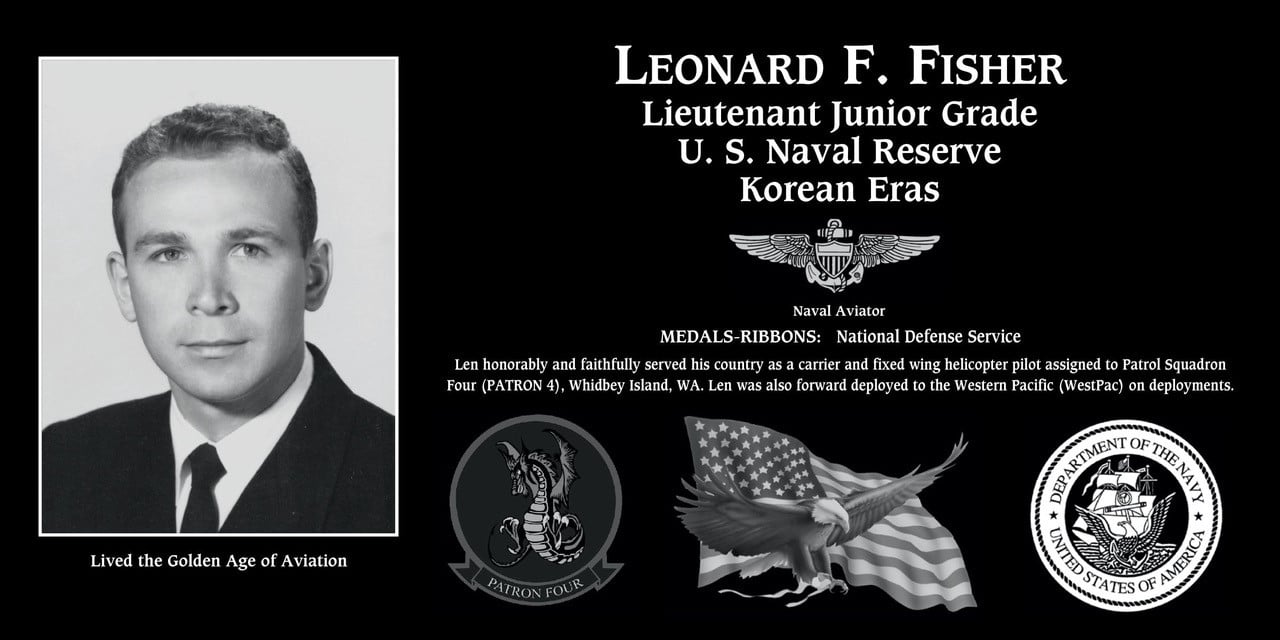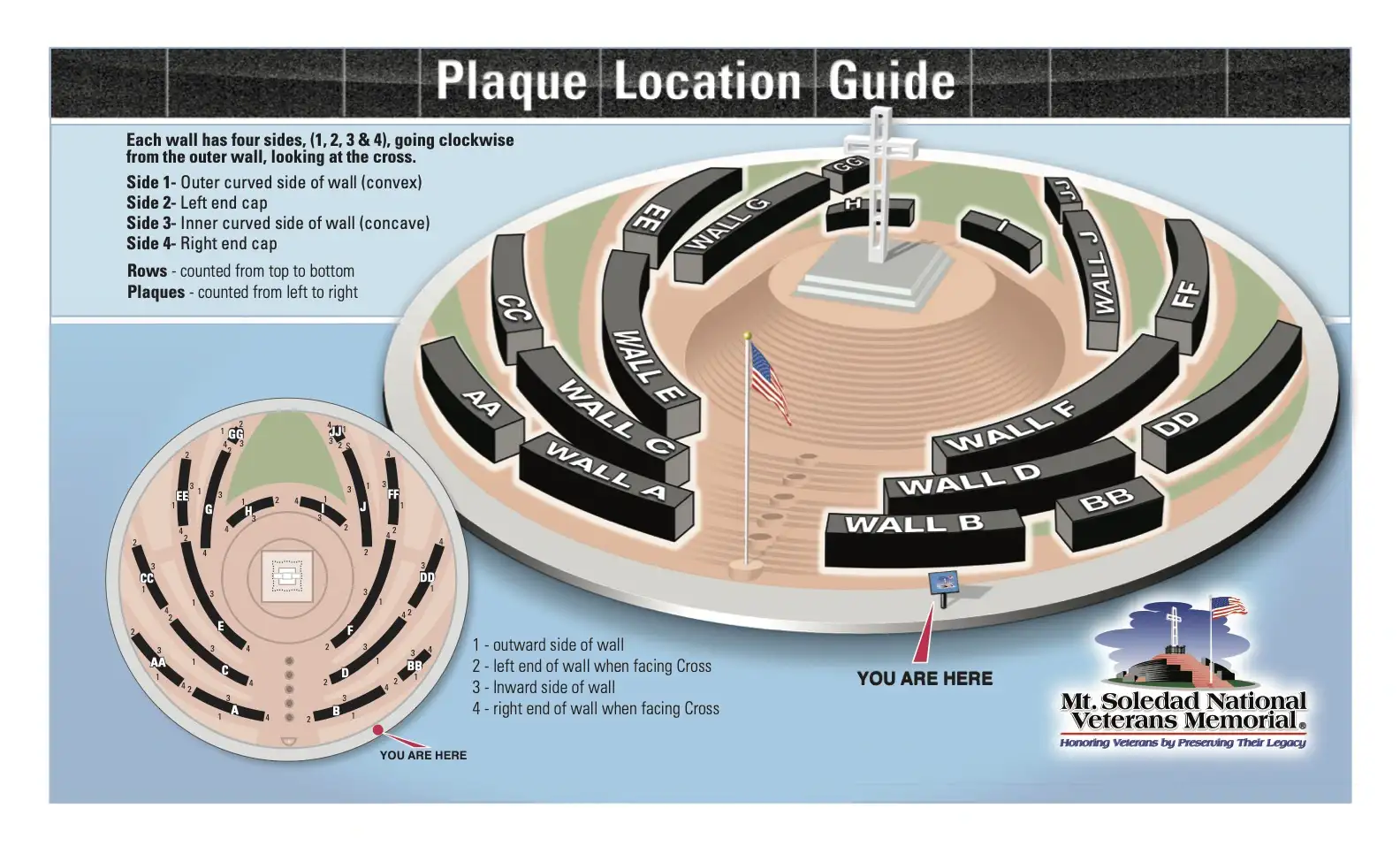Leonard F. Fisher

| Era | Korean War |
|---|---|
| Branch | U.S. Navy |
| Rank | Lieutenant, Junior Grade |
| Wall | G |
| Wall Side | 1 |
| Row | 6 |
| Plaque Number | 25 |
BIO
Captain Leonard Fisher
The Last Flight Out
San Diego, CA – On Saturday, the largest military Air Show in the world will honor Capt. Len Fisher, a Navy Pilot, Korea POW, and a PAN AM pilot who flew into the warzone as South Vietnam was falling to rescue 463 people stranded on the ground in Saigon; in the now famous “Last Flight Out.” On April 24, 1975, with a max capacity of 375, he piloted the 463 passengers on board the dangerously overburdened Boeing 747 to safety; one of the largest and most daring rescues in commercial or military aviation history.
On October 4, 2014 during the Air Show at Marine Corps Air Station Miramar, an expected 100,000 civilians and survivors will stand in unison with military, NASA and government officials in a moment of silence as the Patriots Jet Team flies the historic Missing Man Formation to honor a true American aviation hero, recently deceased Capt. Leonard Fisher.
Update: 240,000 people attended the Airshow on Saturday. The Patriots performed the Missing Man Formation and the Blue Angels performed the Fluer-di-Lis in his honor. In full afterburner and straight towards heaven, the Pilots and attendees, joined with tears. Touching the sky, in thank you and goodbye.
Len Fisher Flying Career
Leonard Fisher began flying in the late ‘40s as a private pilot. Instead of being drafted, he joined the Navy and was soon a carrier pilot. On one fateful mission, while flying reconnaissance over Korea, his aircraft was shot down. He survived his time as a POW and returned to flying for the Navy. When his tour was up, he joined Pan American as a commercial pilot. He flew all types of commercial aircraft, transporting people and goods all over the world. In the mid 80’s Pan Am sold their international routes to United Airlines. In the move, Len became the United Airlines Vice President in charge of opening United’s new Asian division. His work included putting together routes, terminals, ground crews, and counter staff, along with all the flight operations and training for the new pilots. During his flying career, he worked as both a training pilot and a chief pilot, holding both fixed wing type and helicopter type ratings.
During the 70’s and 80’, Len worked for NASA in the Space Shuttle program and the Astronaut program. On the shuttle, he helped build and test the simulator flight control systems. As the shuttle controls were a “fly by wire” system, the simulator data became the shuttle’s electronic flight control system; how the shuttle “felt” and responded when it was flying. He continued to aid in the simulator studies, flying missions from the ground, and building safety and emergency procedures for the shuttle. He helped design and fly the 747 that carried the shuttle on its back across the country. He was part of the Astronaut group that stayed on the ground as control group for the astronauts and participated in the long term health and medical studies of the shuttle astronauts.
In 1986 as part of the group that put together the AirSpace America Airshow in San Diego, he became the first American Pilot to fly a Russian Antonov An-124, the heaviest working aircraft in the world at the time.
He circumnavigated the earth over 100 times using almost every type of navigation device from sextant to GPS in both propeller and jet driven aircraft. He was a President of the Circumnavigators Club, and the only member ever to have 5 family members in the club. He set dozens of commercial aviation speed records, including setting the speed record between Hong Kong and Tokyo, 3 times. He retired from commercial flight in 2001 logging more than 80,000 hours in the sky, landing on every continent and almost every major airport in the world.
As he told it, “he lived the golden age of aviation.”
Len Fisher Life
Born in 1929 in Pittsburgh Pennsylvania, Len Fisher was the first of two boys to Margret and Abe Fisher. He was an Eagle Scout by age 12. His father died when he was 13, causing serious financial hardships for the family. Len immediately started working. At first he did odd jobs, including selling shoes. During high school he learned that high steel paid more, so he began taking jobs doing high rise steel construction. Many men did not like this work so he was generally working with American Indians up on the steel.
After graduating high school, he attended the University of Illinois, Urbana where he studied architecture. He was inspired by the work of Frank Lloyd Wright, reading all his books. Throughout his life he attended every lecture he could from Frank Lloyd Wright. During his time in Urbana he lettered in Gymnastics and Track, breaking his own previous school record for the most points in a single track season. Like many college students at the time, he worked throughout his college career. And since it was available, he took flying lessons offered by the University.
The flying lessons became important when he graduated and joined the Navy. The navy was looking for pilots and his training allowed him to enter as a Lieutenant, Junior Grade. His Naval Flight training included multiple carrier landings. While serving, Len flew both helicopters and fixed wing propeller driven aircraft. His fixed wing flying was mainly reconnaissance missions from land bases in Asia. As one might guess, Len rarely talked about the war and only once discussed being shot down. And because most of his missions were classified, details have been hard to find. What is known is that while he was based in Japan he was shot down by enemy aircraft during a reconnaissance mission. After parachuting out of his plane, he was captured and taken prisoner. The date and the length of time he was a POW is unknown. According to him, he was released through a prisoner trade.
He returned to the states after his service and began working for Pan American World Airways in 1956. As was common with most Pan Am new hires, he was laid off 3 times. During those periods, he worked as an Architect and a businessman.
As an Architect, he designed many single family homes, a number of multifamily dwellings, a few hotels and a few high rises. As he said, “he specialized in whatever walked in the door.” The most notable are his work on renovations of the Imperial Plaza in Japan (now demolished), and some original design work for the Transamerica Pyramid in San Francisco.
As a business man, he started a company that imported tropical fish, he co-founded American Resin and Onyx Company, purchased and developed real estate, was awarded patents for building material, and owned and operated tree ranches in northern California producing almond, walnut, pistachios, and apples.
During his adult life, he lived in the San Francisco bay area, mostly San Rafael California with his wife Gale Brittin Fisher. In the late 80’s Len moved to La Jolla California, commuting to San Francisco and flying international flights for United as a 747 captain.
He was a constant fixture at the Salk Institute in La Jolla, a docent for dignitaries visiting the Institute.
Hobbies and Family Life
Len was an avid fisherman. His wife Gale caught a marlin on their honeymoon. He fished in many countries, but especially enjoyed tuna and marlin fishing out of San Diego. He held a USCG Master license. He spent a lot of time at the San Diego Yacht Club, aboard the yacht aptly named Capt. Fisher.
He is survived by his boys, Bruce, Todd, Kent, Wade, and Edward, four grandchildren Colton, Teagan, Cronan and Vienna, two daughters in law Katie and Erin, and the love of his life, Dr Mary Lou Kehrer (of La Jolla). His list of friends, co-workers, and people he touched are from all over the world, in just about every country.
Plaque Wall Map

